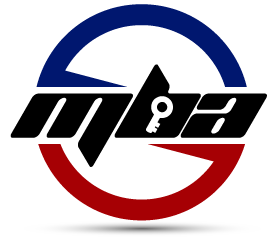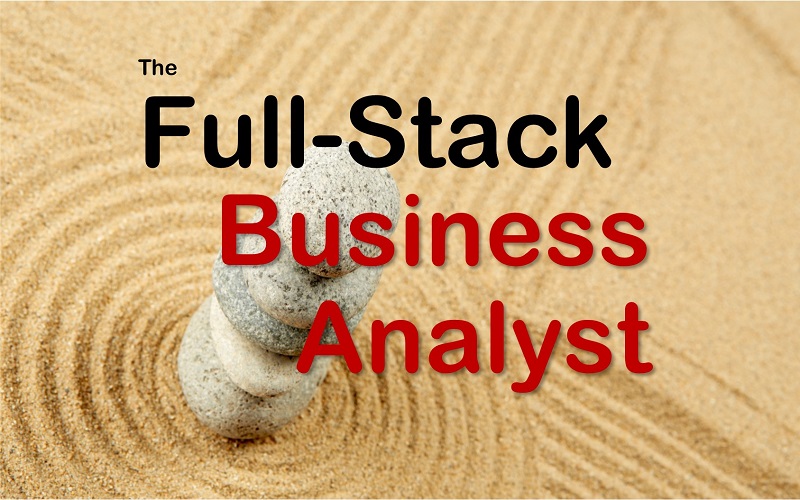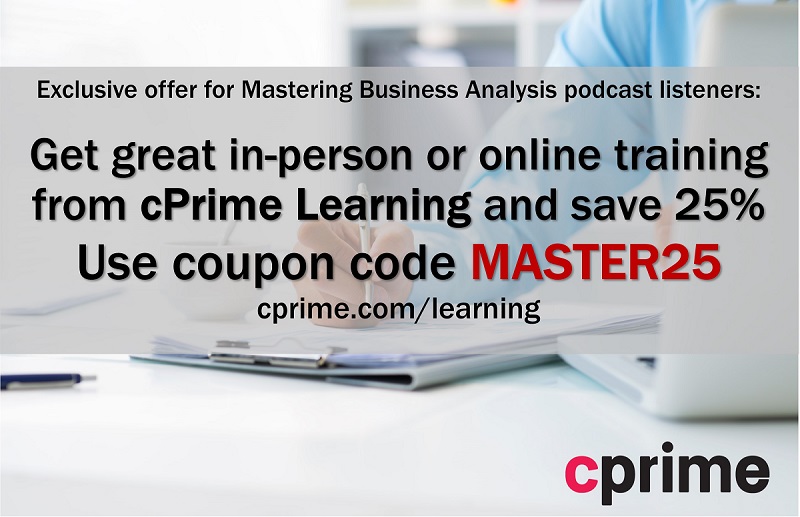In this episode, we explore what it takes to become a Full-Stack Business Analyst. Similar to a Full-Stack Developer, a Business Analyst can broaden their skills to reduce waste and contribute more value to their organization.
After listening to this episode, you'll understand:
- What a Full-Stack Business Analyst is
- Why developing knowledge across the product delivery stack is valuable
- What the components of the product stack are
- How to begin growing your skills
Show Notes
Are you a Full-Stack Business Analyst?
A Full-Stack Developer is someone who’s able to work on the entire technology stack required to deliver the desired functionality. This includes the front-end user interface as well as the back-end database, logic, and other processing systems for an application. Full-Stack doesn’t necessarily imply that you have mastered all of the technology, but you know enough to understand and work on the technology required to deliver the application.
Full-Stack Developers can be a valuable asset to an organization because there are less handoffs, fewer silos, and more awareness of impacts and dependencies from a technical point of view. It also helps with estimation and creating a shared understanding.
If Full-Stack Developers are in high demand and can add value to an organization, with about Business Analysts? What’s our version of full stack?
A Full-Stack Business Analyst is someone who can take an idea from concept to cash. It’s someone who can help identify opportunities and shape products that satisfy a need. They can also rally support for the initiative and gain alignment within the team. These people may also have a strong technical voice to provide input and guidance related to technical solutions and tradeoffs. Finally, they can see the initiative through to completion and ensure ongoing monitoring of results.
Instead of a technology stack, the Full-Stack Business Analyst focuses on the Product Stack, which is comprised of:
- Ideation: Discovering possible opportunities
- Validation: Ensuring that this is a good/the right opportunity
- Visioning: Creating a shared understanding and leading through development of a compelling vision
- Decomposition: Breaking the vision into smaller achievable chunks and identifying experiments to test and learn
- Delivery: Building the solution and getting those solutions into the hands of our customers
- Monitoring: Analyzing metrics to validate success and identify new opportunities
Let’s take a closer look at the Product Stack.
Ideation: Discovering Opportunities
Ideation is where you use data, your knowledge of the business environment, knowledge of your organization’s capabilities, and your understanding of your customers to discover ideas for potential solutions. This may require industry knowledge or research, data mining techniques, and a genuine empathy and understanding of your customers.
Skills and knowledge needed for ideation include problem analysis and identification of opportunities through SWOT, SLEPT, or PESTEL analysis. You may also use approaches such as Design Thinking or Lean Startup and tools like personas, empathy maps, customer journeys, and experiments.
Validation: Confirming it’s the Right Opportunity
Validation occurs when you analyze your idea to make sure there’s good problem/solution fit as well as good product/market fit. You want to ensure that the product idea meets an important customer need, customers are willing to pay for it (or willing to use it for an internal product context), and that it’s scalable and marketable.
An understanding of marketing, product management, and finance is needed here. You’ll likely develop a business case as part of the validation to ensure that the product idea is worth the investment and to help with prioritization.
Visioning: Gaining Buy-In and Alignment
Once you have validated the product idea, you’ll need buy-in from your organization to get the time, money, and other resources you need to make the idea come to life. This involves influencing, using data from your earlier validation, creating a compelling vision, and creating alignment by developing a shared understanding of the problem, proposed solution, metrics, and expected outcomes.
Decomposition: Making Work Manageable
Even if you have a great product idea and alignment in your organization, it’s difficult to understand and deliver the solution in one big piece. We need to break the work down into smaller, more manageable pieces.
Not only does decomposing work help with creating a shared understanding, it also allows you to experiment and create smaller feedback loops to adapt or pivot as to deliver. This gives you the opportunity to get frequent feedback, revisit and revise your product idea, and create solutions your customers will love.
This includes a lot of the typical business analysis work of requirements elicitation and analysis.
When you decompose work, you’ll likely identify the Minimum Viable Product (MVP) and Minimum Marketable Features (MMF). You can also use techniques such as Story Mapping to create a holistic view of the initiative as well as thin slices to deliver.
You may also need to build models to discover new information and create a shared understanding. Prototypes, wireframes, and mockups may also be used to gain clarity and create a great customer experience.
Delivery: Getting the Right Solution to Customers
Once you have alignment and an understanding of how the product can be delivered, it’s time to build the solution. Whether you’re developing in iterations or a big bang implementation, you’ll want to create fast feedback loops and adjust your approach along the way.
Familiarity with technology will help to better understand any development challenges, options, risks, and dependencies.
Once the product (or product increment) is built, it needs to be tested before you release it to production. Familiarity with testing approaches allows you to ensure product quality. Whether it’s creating User Stories with acceptance criteria in Gherkin format, actually writing test cases, performing User Acceptance Testing (UAT), or ensuring quality in some other way, this is a critical piece of product delivery.
The other component beyond building the solution and testing it is getting the product into the hands of customers. Knowledge about how your organization delivers products will help you provide more value and reduce delays. This may mean learning about DevOps practices.
It also means that you need to understand change management approaches. You often won’t be successful without preparing your customers for the change; especially internal customers. You may need to develop instructions, update user guides, and provide training before you deliver the product.
Monitoring: Metrics for Success
Just because you successfully deliver the product, your job as a Full-Stack Business Analyst isn’t done. How do you know if you achieved the intended outcome?
You need to be able to monitor the product, its usage, and metrics. Doing so allows you to validate your original hypothesis and helps you to discover new opportunities.
The Most Valuable Skill
Focusing on the entire stack from concept to cash can lead to the perception of being a jack of all trades, but master of none. This leads to the specialist versus generalist debate, which can be the subject of an entire episode by itself.
My preference is to develop T-shaped skills (or its variations) where you have depth of understanding in a few key areas and narrow but wide knowledge of other facets.
All of the skills and focus areas that we discussed sounds like a lot, so don’t get overwhelmed. Realize that you don’t need to master all of these areas. Think about what full stack means to you and your organization and them begin filling in the gaps. Learn just enough to meet the most immediate need and then shift to another area.
The most valuable skill is the desire and ability to learn and to be self-aware enough to know when you don’t know something. Having a natural curiosity and eagerness to learn new things will help you grow and increase your ability to contribute value every day.
Listen to the full episode to better understand the value that a Full-Stack Business Analyst can bring to an organization and how to develop your skills.
Your Homework
Examine what ‘full-stack’ means to you and your organization. Start filling in some of the gaps by finding the most valuable skills and learning them. Learn just enough to meet the most immediate need and then shift to another area of learning.
Thank you for listening to the program
To get more valuable content to enhance your skills and advance your career, you can subscribe on iTunes.
Also, reviews on iTunes are highly appreciated! I read each review and it helps keep me motivated to continue to bring you valuable content each week.



